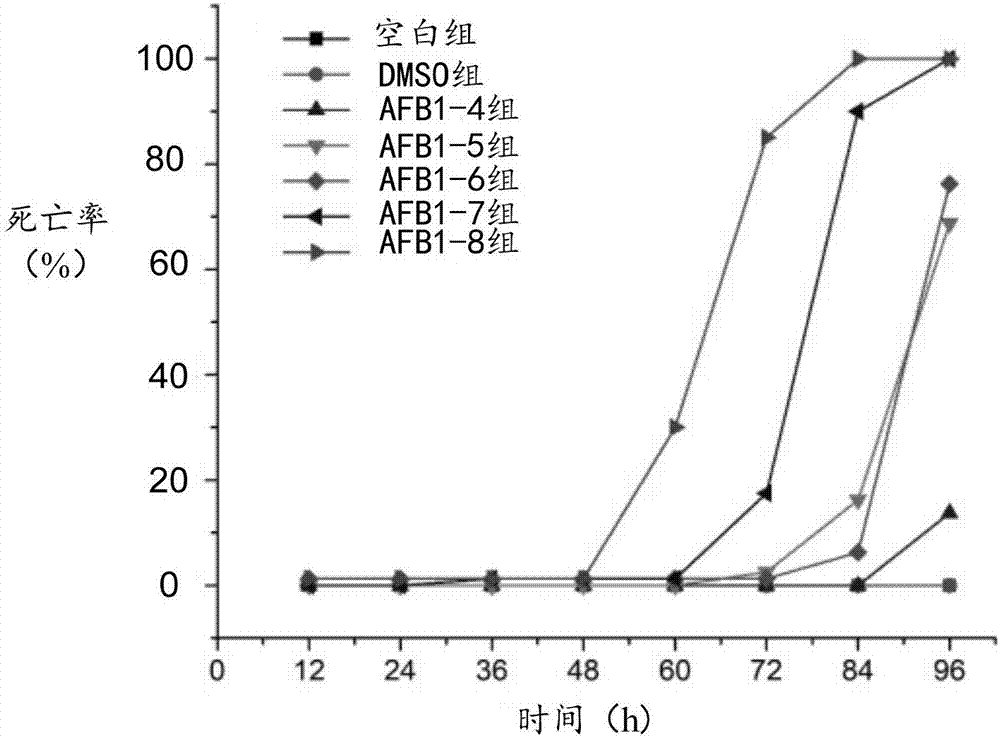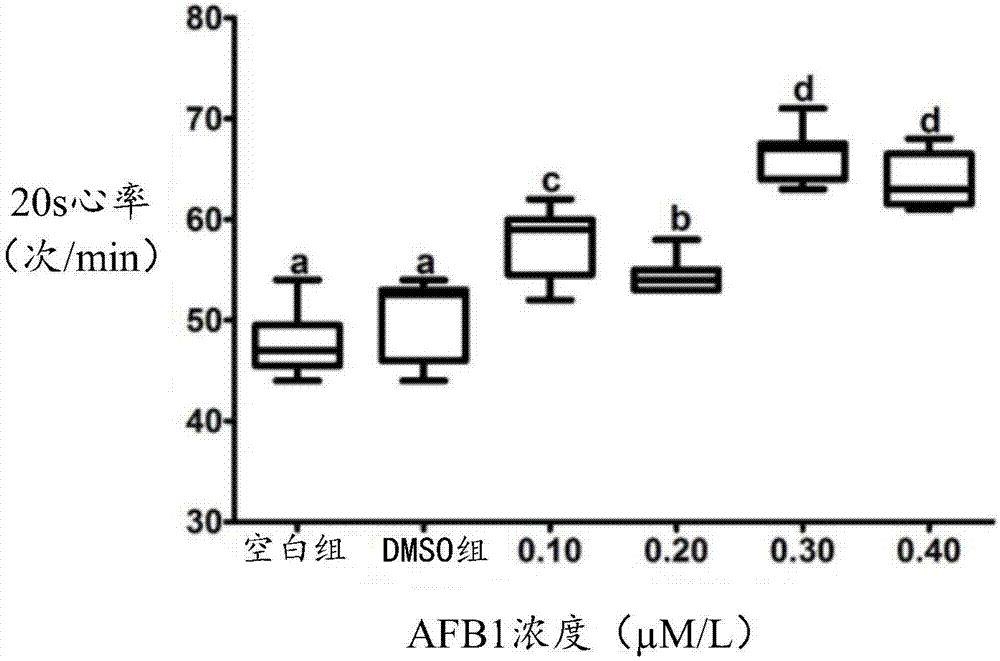Method for detecting toxicity of aflatoxin B1
A technology of aflatoxin and detection method, which is applied in the field of detection of aflatoxin B1 toxicity, can solve the problems of low single litter size, high research cost, long animal reproduction cycle, etc., achieve easy observation, reduce test cost, The effect of improving efficiency
- Summary
- Abstract
- Description
- Claims
- Application Information
AI Technical Summary
Benefits of technology
Problems solved by technology
Method used
Image
Examples
Embodiment 1
[0076] Zebrafish feeding and management methods are as follows:
[0077] (1) Breed zebrafish in a constant temperature circulating water system. The water used for breeding is tap water heated by aeration. Heating rods are used to heat the water tank to maintain the water temperature at 28±1°C, the dissolved oxygen is greater than 5.0mg / L, and the pH is 7.0± 0.2, light alternately (light 14h / dark 10h). Among them, the feeding bait for adult fish is small tropical fish feed (purchased from Beijing Crazy Aquatic Plant Company) and Artemia worm, and they were fed at 7:00~9:00, 12:00~15:00 and 18:00~20:00 every day. bait; the feeding bait for juvenile fish is paramecium, which is fed once a day.
[0078] (2) Breeding method of Artemia: Add 800mL of water, 3.2g of salt and a little worm into the hatching bottle, put the whole device into the bucket, use a heating rod to heat the water to keep the water temperature at 28±1°C; Inflate the airnia to keep the Artemia eggs in a state ...
Embodiment 2
[0081] Zebrafish embryos were selected as follows:
[0082] (1) At 9:00 the night before egg collection, move zebrafish (female to male ratio 1:3) from the culture tank to the spawning box with a fishing net, and put the spawning box into an artificial climate box (RTOP1000B, Zhejiang Top Instrument Co., Ltd.) overnight, the temperature was controlled at 27±1°C, and the light was turned on at 9:00 the next morning to allow the female and male fish to mate naturally, and fertilized eggs were collected 15 minutes later;
[0083] (2) Place the fertilized eggs in a plate, use a plastic dropper to clean up the feces and impurities, and culture them in an artificial climate box for 3 hours, the temperature is controlled at 27±1°C, and use a dissecting mirror to select the eggs that develop normally 3 hours after fertilization Gastrula.
Embodiment 3
[0085] The preparation of the culture solution with different AFB1 concentrations is as follows:
[0086] (1) Configuration of DMSO mother solution: Take 10 mL of DMSO (analytical pure) in a 4°C refrigerator and put it into a test tube, wrap the test tube with tin foil, store it at room temperature, and use it as a test DMSO mother solution;
[0087] (2) Configuration of DMSO stock solution: pipette 0.5 mL of DMSO mother solution into a centrifuge tube, add 49.5 mL of aquaculture water, and configure 50 mL of DMSO solution with a volume concentration of 1% of DMSO;
[0088] (3) Configuration of AFB1 mother liquor: Take 1mg of AFB1 pure product (99.9%), add 1mL of DMSO mother liquor, place the mixture in an ultrasonic breaker (20-25kHz) for crushing treatment for 10min, shake well, and make AFB1 concentration AFB1 stock solution of 3200μM / L;
[0089] (4) Configuration of AFB1 stock solution: use a pipette to draw 100 μL of AFB1 mother solution into a centrifuge tube, add cultu...
PUM
 Login to View More
Login to View More Abstract
Description
Claims
Application Information
 Login to View More
Login to View More - R&D
- Intellectual Property
- Life Sciences
- Materials
- Tech Scout
- Unparalleled Data Quality
- Higher Quality Content
- 60% Fewer Hallucinations
Browse by: Latest US Patents, China's latest patents, Technical Efficacy Thesaurus, Application Domain, Technology Topic, Popular Technical Reports.
© 2025 PatSnap. All rights reserved.Legal|Privacy policy|Modern Slavery Act Transparency Statement|Sitemap|About US| Contact US: help@patsnap.com



